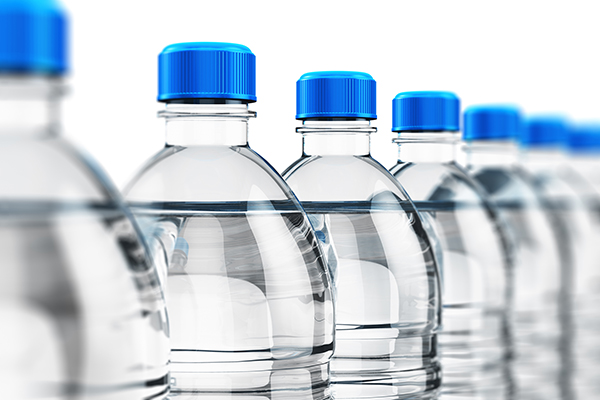- Never ration drinking water unless ordered to do so by authorities. Drink the amount you need today and try to find more for tomorrow. Minimize the amount of water your body needs by reducing activity and staying cool.
- Drink water that you know is not contaminated first. If necessary, suspicious water, such as cloudy water from regular faucets or water from streams or ponds, can be used after it has been treated. If water treatment is not possible put off drinking suspicious water as long as possible but do not become dehydrated.
- Do not drink carbonated or caffeinated beverages instead of drinking water. Caffeinated drinks and alcohol dehydrate the body which increases the need for drinking water.
Water Storage
Buy commercially bottled water and store it in the sealed original container in cool, dark place.
If you must prepare your own containers of water, purchase food-grade water storage containers. Before filling with chlorinated water, thoroughly clean the containers with dishwashing soap and sanitize the bottles by cleaning with a solution of one teaspoon of non-scented liquid household chlorine bleach to a quart of water. Water that has not been commercially bottled should be replaced every six months.
Water Treatment
If you have used all of your stored water and there are no other reliable clean water sources, it may become necessary to treat suspicious water. Treat all water of uncertain quality before using it for drinking, food washing or preparation, washing dishes, brushing teeth or making ice. In addition to having a bad odor and taste, contaminated water can contain microorganisms (germs) that cause diseases such as dysentery, cholera, typhoid and hepatitis.
There are many ways to treat water. Often the best solution is a combination of methods. Before treating, let any suspended particles settle to the bottom or strain them through coffee filters or layers of clean cloth.
|
Chlorination
You can use household liquid bleach to kill microorganisms. Use only regular household liquid bleach that contains 5.25 to 6.0 percent sodium hypochlorite. Do not use scented bleaches, color safe bleaches or bleaches with added cleaners.
Add 1/8 teaspoon of bleach per gallon of water, stir and let stand for 30 minutes. The water should have a slight bleach odor. If it doesn’t, then repeat the dosage and let stand another 15 minutes. If it still does not smell of chlorine, discard it and find another source of water.
Other chemicals, such as iodine or water treatment products sold in camping or surplus stores that do not contain 5.25 or 6.0 percent sodium hypochlorite as the only active ingredient are not recommended and should not be used.
|
Distillation
While boiling and chlorination will kill most microbes in water, distillation will remove microbes (germs) that resist these methods, as well as heavy metals, salts and most other chemicals. Distillation involves boiling water and then collection of only the vapor that condenses. The condensed vapor will not include salt or most other impurities.
To distill, fill a pot halfway with water. Tie a cup to the handle on the pot’s lid so that the cup will hang right-side-up when the lid is upside-down (make sure the cup is not dangling into the water) and boil the water for 20 minutes. The water that drips from the lid into the cup is distilled.
|
Boiling
Boiling is the safest method of treating water. In a large pot or kettle, bring water to a rolling boil for one full minute, keeping in mind that some water will evaporate. Let the water cool before drinking.
Boiled water will taste better if you put oxygen back into it by pouring the water back and forth between two clean containers. This also will improve the taste of stored water.
External Sources:
 Determining Water Needs
Determining Water Needs